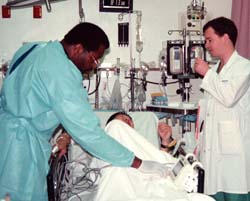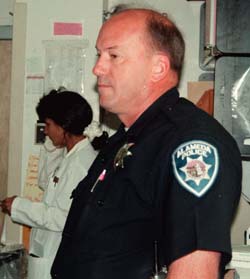| No Cheap
Shot: the financial toll of gun violence
An ambulance came to pick Juan up and paramedics notified the Trauma Center at Highland Hospital that they would soon arrive with a gunshot wound (GSW). The hospital phoned the surgeon on call that night, Dr. Vernon Henderson, who was at home asleep. By the time Henderson reached Highland, Juan was prepped for surgery. Henderson, who is chief of Highland's trauma department, two residents, a team of nurses, an anesthesiologist and the anesthesiologist's assistants worked on Juan for several hours. The surgeons were able to save all of Juan's damaged organs. After surgery, Juan was taken to the Intensive Care Unit (ICU) where he stayed in stable condition for about a week. He was doing well, so doctors transferred him out of the ICU to a unit for patients in less critical condition. If there are no complications, he will be released after spending a little over two weeks in the hospital. It will take about two months for Juan to recover completely. Because of the seriousness of his injury, there was a flat-rate charge of $5800 just to admit Juan to the Trauma Center. Each day in the ICU tacked on a basic daily rate of approximately $2800 a day. Drugs and nursing care are billed on top of that. Because Juan, 21, has no medical insurance, no family and no personal wealth, Highland will likely absorb the cost of his hospitalization. Estimating conservatively, Juan's run-in with the tiny metal bullet--which can cost as little as 33 cents--may end up costing the hospital anywhere between $30,000 to $60,000. "When a bullet enters the body it bounces all over--it doesn't travel in a straight line," said Dr. Lisa Benton, a Highland trauma surgeon. There is no predicting where a bullet will go when it enters the body. It depends on angle of the bullet's entry, the distance the gun is fired from, what part of the body the bullet hits. A bullet to the shoulder can glance off the collar bone and out of the body, or it can bounce off the bone and head directly into the heart. The bullet that hit Juan punched through the right side of his lower back, passed through a kidney, his colon, a section of his small intestines and through the major vein that carries blood from the body's extremities back to the heart before lodging in front of his spinal column. In all, he lost about 12 liters of blood. Henderson said Juan's case was relatively straightforward and presented no complications. Highland, which houses one of Alameda's two trauma centers, treats some 85 percent of the county's violent traumas. In 1996 gunshot wounds accounted for 18 percent of patients admitted to the trauma center. The number of cases per month ranged from a high of 55 cases to a low of 21 cases. One patient's 28-day hospitalization cost more than $1.1 million. The tab for another patient's 3-day hospital stay ran about $18,000. Another gunshot victim's hospitalization came to just over $68,000. Some gunshot victims are covered by medical insurance that pays for some of the cost, but often gunshot victims, like Juan, are uninsured. If the patient was injured while committing a crime, the criminal justice system absorbs the cost of the patient's hospitalization. Otherwise, Highland foots the bill. |
Registered nurse Kuwaza Imara (left) and Dr. Searles
care for a car crash victim in Highland Hospital's Trauma
Center.
Dr. Lawrence Goldstein (second from right) and other
Highland doctors examine a trauma patient's X-rays.
Officer Al Paladini, of the Alameda Police Department,
looks on as trauma staff treat a patient injured as he
fled from police. Related
Stories |


